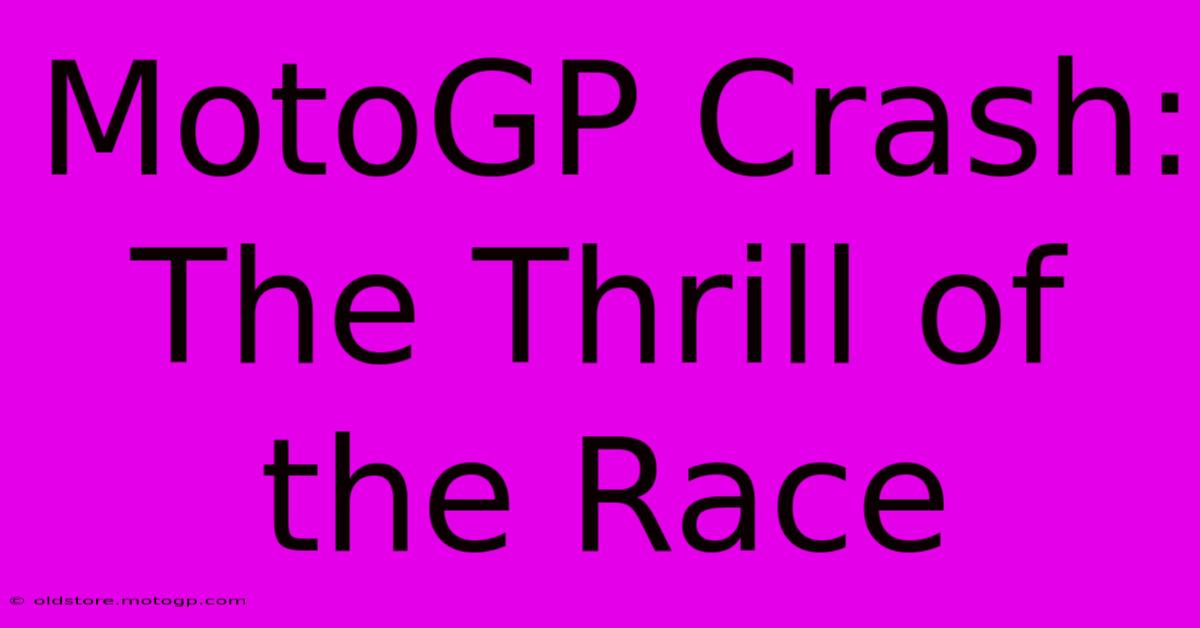MotoGP Crash: The Thrill Of The Race

Table of Contents
MotoGP Crash: The Thrill of the Race – A High-Octane Sport
MotoGP. The name itself evokes images of screaming engines, breathtaking speeds, and the sheer, unadulterated thrill of competitive racing. But interwoven with the exhilaration are the inherent risks, and the ever-present possibility of a crash. While crashes are undoubtedly dangerous, they also form a significant, albeit unsettling, part of the MotoGP narrative. This article delves into the world of MotoGP crashes, exploring the factors contributing to them, the safety advancements mitigating their impact, and the enduring appeal they hold for fans.
The Perilous Dance: Understanding MotoGP Crashes
MotoGP bikes are incredibly powerful machines, capable of reaching speeds exceeding 200 mph. Riders navigate challenging circuits, pushing their limits and the boundaries of physics at every turn. Several factors contribute to crashes:
1. Human Error: The Biggest Culprit
While mechanical failures certainly occur, human error accounts for the vast majority of MotoGP crashes. This encompasses:
- Rider mistakes: Over-ambitious overtaking maneuvers, loss of control in challenging conditions (wet tracks, strong winds), and simple errors in judgment all contribute to crashes.
- Rider fatigue: The intense physical and mental demands of MotoGP racing can lead to fatigue, impacting reaction time and decision-making.
- Strategic errors: Incorrect tire choices, poor race planning, and misjudgments regarding opponent's behavior can lead to accidents.
2. Mechanical Failures: The Unforeseen
While less common than human error, mechanical failures can also cause crashes. These include:
- Tire failures: Punctures or tire degradation can lead to sudden loss of control.
- Engine problems: Unexpected engine failures can leave a rider stranded on the track, vulnerable to other competitors.
- Brake failures: A loss of braking power can have catastrophic consequences at high speeds.
3. External Factors: The Uncontrollable
External factors, while sometimes beyond the rider's control, also play a role:
- Track conditions: Wet or oily tracks significantly reduce grip, increasing the risk of crashes.
- Other riders: Collisions with other competitors are a frequent cause of crashes, particularly during intense overtaking battles.
- Track obstacles: Unexpected debris or imperfections on the track can cause riders to lose control.
Safety Advancements: Minimizing the Risk
The safety of MotoGP riders has improved drastically over the years, thanks to significant advancements in technology and safety protocols:
- Protective gear: Sophisticated leathers, helmets, and other protective gear absorb much of the impact in a crash.
- Trackside medical care: Rapid response medical teams and advanced medical facilities ensure the best possible care for injured riders.
- Improved bike design: Modern MotoGP bikes incorporate safety features designed to mitigate the impact of crashes, including improved chassis design and safety systems.
- Safety barriers: Tracks incorporate advanced safety barriers and runoff areas to cushion impacts and minimize injury.
The Enduring Appeal: Beyond the Danger
Despite the inherent risks, the thrill of MotoGP racing continues to captivate millions. The crashes, while alarming, become part of the sport's captivating narrative. They highlight the courage, skill, and precision required to compete at the highest level of motorcycle racing. They remind us that MotoGP is a sport pushing the boundaries of human potential and technological innovation. The tension, the drama, and the sheer spectacle of riders battling at breakneck speeds, even with the possibility of a crash, make MotoGP an unforgettable and unparalleled spectacle.
SEO Considerations and Optimization:
This article incorporates several SEO best practices:
- Keyword Optimization: The article naturally integrates relevant keywords such as "MotoGP crash," "MotoGP safety," "MotoGP accidents," "motorcycle racing," and "racing accidents."
- Header Tags (H2, H3): Clear and concise header tags improve readability and structure, signaling important sections to search engines.
- Bold and Strong Tags: Emphasis on key terms and phrases enhances readability and highlights important information.
- Long-Tail Keywords: Phrases like "factors contributing to MotoGP crashes" and "safety advancements in MotoGP" target more specific search queries.
- Content Quality: The article aims for comprehensive and informative content, providing valuable insights into the topic.
- Readability: The writing style prioritizes clarity and readability to keep readers engaged.
This comprehensive approach aims to improve the article's search engine ranking and attract organic traffic. Remember to promote the article through social media and other channels for wider reach.

Thank you for visiting our website wich cover about MotoGP Crash: The Thrill Of The Race. We hope the information provided has been useful to you. Feel free to contact us if you have any questions or need further assistance. See you next time and dont miss to bookmark.
Featured Posts
-
Austin F1 Qualifying Under Pressure
Feb 24, 2025
-
Cota Lot H Risk Free Trial
Feb 24, 2025
-
Unmatched Speed And Handling Moto Gp Machine Awaits
Feb 24, 2025
-
Moto Gp Aero The Future Of Motorcycle Design
Feb 24, 2025
-
The Benefits Of Interactive Moto Gp Commentary
Feb 24, 2025
